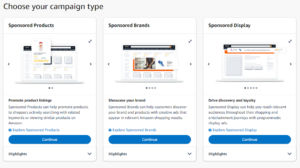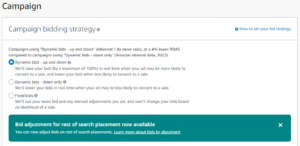
Amazon Advertising is essential for businesses looking to boost their sales and increase their return on investment (ROI). With millions of shoppers visiting the platform daily, Amazon advertising provides a unique opportunity to reach a more highly targeted audience than ever.
Without a well-defined plan, your advertising efforts may be wasted or fail to generate the desired results.
This article will explore the best practices every brand with an effective Amazon PPC advertising strategy follows.
Clear goals and Optimization
An effective advertising strategy starts with clearly defining your goals and target audience. Are you looking to increase product visibility, drive sales, or promote a new product launch? Knowing your objectives will help you choose the right advertising campaign and optimize your product listings accordingly.
Additionally, conducting thorough market research and competitor analysis is a must for developing a successful advertising strategy. By understanding what your competitors are doing and identifying gaps in the market, you can position your products strategically and create compelling ad campaigns that resonate with your target audience. Regular monitoring and analysis of your advertising performance will allow you to make data-driven decisions and optimize your strategy for better results.
Ensure your campaigns are profitable, meaning the profit generated exceeds the ad spend. Increase Customer Lifetime Value (CLV) to create long-term profits, even if it means increasing your ad spend.
Choose your Amazon Advertising Campaign
Amazon offers several campaign options for different advertising goals and budgets. Understanding the different campaign types will help you choose the most suitable option:
- Sponsored Product Ads – These ads promote individual products and appear in search results and product detail pages. They are cost-effective and drive targeted traffic to specific product listings.
- Sponsored Brands Ads – These include your brand logo, a custom headline, and multiple products. They appear at the top of search results, driving brand visibility and helping shoppers discover your products.
- Sponsored Display Ads – These ads target relevant audiences on and off Amazon. They can be used to retarget customers who have viewed your product or to reach new audiences through display placements.
The best way to choose the right Amazon advertising option for your business is to consider your funnel and your goals. Determine whether your primary goal is to increase product visibility, drive sales, or promote your brand.
Evaluate your budget and consider each campaign type’s cost-per-click (CPC) rates. Sponsored Products generally have lower CPC rates, making them more cost-effective for smaller budgets.
Combining these campaign types allows you to maximize your brand’s visibility, increase product sales, and achieve your advertising goals effectively.
Typically, an advertiser will leverage Sponsored Products ad types at a minimum. Most organizations run all campaign types to cover the shopper’s journey sufficiently.
Optimizing your PPC campaigns
Optimizing your PPC campaigns is important once you’ve chosen the right Amazon advertising option for your business. Here are a few tips:
- Set clear goals for your campaigns – What do you want to achieve? Do you want to increase sales, increase brand awareness, or conquesting competitor listings? What KPIs are most important to you? Once you know your goals, you can adjust your campaigns accordingly.
- Choose the right keywords – Targeting the right keywords to succeed with Amazon PPC. Use Amazon’s Keyword Tool to research keywords relevant to your products and services.
- Monitor your results – It’s important to track the results of your PPC campaigns and make adjustments as needed. This will help you ensure you get the most out of your ad spend.
Bidding Strategies
Optimizing your bidding strategy is crucial for maximizing your ROI on Amazon Advertising. Here are some bidding strategies to consider:
- Manual Bidding – Take control of your bidding by manually setting your bids on the keyword or ad group level. This strategy allows for more fine-tuned adjustments based on keyword performance.
- Bid Adjustments – Analyze the performance of your keywords and adjust your bids accordingly. Increase bids for keywords that drive high conversions and decrease bids for underperforming keywords. Use CPC or CPM as a baseline for bid adjustments.
- Dynamic Bidding – Amazon’s algorithm automatically sets bids based on whether your ad is less or more likely to convert. This option often preserves ad spend when gaining profit is unlikely so that it may be ideal for your budget and campaign goals. This strategy is an excellent option for beginners or those with limited time for manual bid adjustments.
By testing and optimizing your bidding strategies, you can find the right balance that maximizes your advertising ROI while staying within your budget.
Adapt to your buyers’ journey.
The buyer’s journey is the process potential customers go through when purchasing. It usually consists of three stages: awareness, consideration, and decision.
- Awareness – The buyer realizes they have a problem or need. They’re not necessarily ready to buy anything yet, but they’re starting to research different options.
- Consideration – The buyer evaluates different products or solutions, trying to determine which option is best for them.
- Decision – The buyer selects a product. They’re looking for the best deal possible.
The main objective is adapting your Amazon Advertising Strategy to each stage of the buyer’s journey. At the awareness stage, you should create ads that grab potential customers’ attention and introduce them to your brand. Use broad keywords to target potential customers interested in similar products or services. When a buyer is considering your product, use more specific keywords to highlight your product’s unique selling points. At the decision stage, we finally convert by offering competitive prices and making it easy for customers to checkout.
These stages of the buyer’s journey aren’t an exact science. Remember, each brand must have its own custom journey map. The buyer’s journey varies depending on how customers are usually introduced to your products.
Adapting to your buyers’ journey will increase your chances to convert while helping you create a customer-centric marketing strategy.
Conclusion
Following the best practices outlined in this article will help you create and implement a successful Amazon Advertising strategy that maximizes your ROI and conversion rates. However, an excellent Advertising Strategy isn’t the only key to success. Consider other factors like inventory management, pricing strategy, and product listings when growing on Amazon.
BellaVix can help you reach your short-term and long-term goals by supporting your PPC Advertising, Amazon Display, Seller Central Management, and more. If you have additional questions, contact the BellaVix Team.
Keep up with the latest Amazon and Walmart news updates and subscribe to our BellaVix newsletter 👇👇👇


